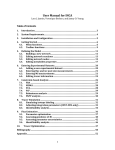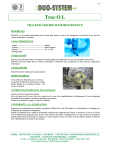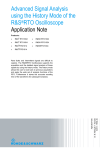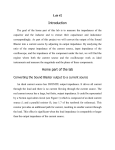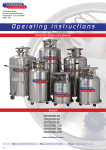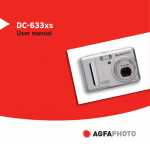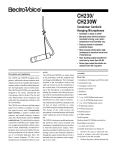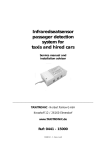Download Display Standards
Transcript
Bundesamt für Seeschifffahrt und Hydrographie Federal Maritime and Hydrographic Agency Display Standards Applicability of the display standard for navigational equipment to small displays We have reviewed the display standards under the aspects of the applicability for displays of other navigational equipment than Radar and ECDIS. The following standards which are related to navigational displays have been developed with emphasis to Radar and ECDIS displays but are in general applicable to all displays of navigational equipment. We distinguish between the following terms for display types: • “Operational displays” are ECDIS (ECS) and Radar displays • “Small displays” are the other displays, independent of the real (physical) size of the display. Resolution MSC.191(79) (Adopted on 6 December 2004) Performance standards for the presentation of navigation-related information on shipborne navigational displays. IEC 62288 Edition 1.0 2008-07 Maritime navigation and radiocommunication equipment and systems – Presentation of navigation-related information on shipborne navigational displays – General requirements, methods of testing and required test results SN/Circ. 243 Guidelines for the presentation of navigation-related symbols, terms and abbreviations The following sections encompasses comments to items which are important, imply additional or modified requirements for equipment or require interpretation. Cited text from the a.m. standards is set in italics Overview • • • • • • The display standards are applicable for all navigational displays (according to SOLAS V) Sections 5 and 8 of the performance standard and sections 4 and 7 of the test standard are applicable for all displays including small displays. Sections 6 and 7 of the performance standard and sections 5 and 6 of the test standard are applicable for RADAR and ECDIS. The display standards do not replace the IEC 60945 and the individual equipment standards but extend these standards and have priority in case of conflicts. The requirements of the display standards are applicable for the display of navigational information, but not e.g. for configuration screens. The requirements are applicable also for optional displays but do not require additional functionality. 1 2010-02-08 Bundesamt für Seeschifffahrt und Hydrographie Federal Maritime and Hydrographic Agency • • • • • • • • • • • Symbols, navigational terms, abbreviations and units shall be used according to SN/Circ. 243 and IEC 62288 Annexes A and B. A clearly legible non-italic, sans-serif font shall be used for the display of text. Displays have to be illuminated. A night mode with light foreground on dark background is required. Multicolour displays are not generally required if not required by the equipment standard. The source of navigational information has to be displayed if it is not obvious because of the type of equipment. The validity and integrity of information shall be indicated Means should be provided to immediately make the user aware of a presentation failure on an operational display. It is not required that the display can be dimmed down to complete extinction but to 1 cd/m2. The display should support the reading of information by at least two users, from standing and sitting operator positions. 3 physical measurements are required: • Brightness • Variation of brightness • Flicker Performance standards Resolution MSC.191(79) 1 Purpose ... for the presentation of navigation-related information on the bridge of a ship... The purpose is limited to navigation-related information. So there are no requirements for screens which do not present any navigation-related information, e.g. maintenance or set-up screens. In our understanding these standards are also applicable for the optional presentation of navigation-related information which is not required by the Organization. On the other hand we understand that it is only related to the presentation of the information, that means that additional functionality is not mentioned. ... all navigational displays ... This explicitly defines that these performance standards are not only applicable for Radar and ECDIS displays but also for all other navigational displays on the bridge. In our understanding this is all equipment which is covered by SOLAS chapter V. These performance standards supplement and, in case of a conflict, take priority over, presentation requirements of the individual performance standards ... In case of existing individual performance standards the display standards - supplement the individual standards - take priority over the individual standards in case of conflicts. 2 2010-02-08 Bundesamt für Seeschifffahrt und Hydrographie Federal Maritime and Hydrographic Agency ... and cover the presentation of navigation-related information by equipment for which performance standards have not been adopted. It is also applicable if no individual equipment standard exists. 2 Scope ... in addition to presentations required by the individual performance standards ... This again indicates that the requirements are additional to the requirement of the individual performance standards. 3 Application The general principles of these standards are applicable for all displays on the bridge of a ship.* *The general principles are addressed in paragraphs 5 and 8. After checking the contents of paragraphs 6 and 7 and realise that they cover ECDIS and Radar presentation and displays only, we conclude that only the paragraphs 5 and 8 are applicable for Small displays. In addition to the general requirements set out in resolution A.694(17)** ** IEC Publication 60945 (see Appendix 1). The requirements of the display standards do not replace the requirements from A.694(17) and IEC 60945 regarding display of information but define additional requirements. ..., as applicable This limits the application to requirements which are appropriate to the individual type of display. The applicable requirements are subject to individual agreements with the type approval authority. 5 General Requirements for the presentation of information As mentioned above the requirements in this paragraph are generally valid for all types of navigational displays. 5.1.1 (5.1 Arrangement of information) The presentation of information should be consistent with respect to values, units, meaning, sources, validity, and if available, integrity. To get the consistency the units as defined in SN/Circ. 243, Annex 2, page 8, should be used. 5.2.2 (5.2 Readability) Alphanumeric data and text should be presented using a clearly legible non-italic, sans-serif font. 3 2010-02-08 Bundesamt für Seeschifffahrt und Hydrographie Federal Maritime and Hydrographic Agency Different to A.694(17) and IEC 60945 which do not require a dedicated font the performance standards require a dedicated non-italic, sans-serif font. 5.2.3 (5.2 Readability) Navigation terms and abbreviations should be presented using the nomenclature defined in SN/Circ.243. It is clearly required that the navigation terms and abbreviations of SN/Circ. 243 have to be used. 5.3.2 (5.3 Colours and intensity) The colours and brightness should take into account the light conditions of daylight, dusk and night. We conclude from this requirement that LCD displays without backlight are not allowed, because they are not legible at night light conditions without external light. The presentation should support night viewing by showing light foreground information on a dark nonreflecting background at night. The display has to support a mode with light foreground on dark background. This is a more definitive requirement than the expression of IEC 60945: “All information shall be presented on a background of high contrast, emitting as little light as possible at night, so that it does not degrade the night vision of the officer of the watch.“ For small displays with a small light emitting area (e.g. less than approx. 50 cm²) it can be accepted to have light background mode only because it is considered not to unduly affect the OOW. The inverse mode (dark foreground on light background) is not explicitely required but may be appropriate for daylight conditions. LED-7-segment displays are allowed because they show light numbers/ characters on dark background. 5.5 Coding of information When colour coding is used... This expression implies that colour coding is not generally required. When colour coding is used, the colour red should be used for coding of alarm related information. It does not say that “red” shall “only” be used for alarm related information, but in case colour coding is used this is highly recommended. It is understood that monochrome displays that do not use colour coding could be red (e.g. 7segment LED). 5.6.1 (5.6 Integrity marking) The source, validity, and where possible, the integrity of information should be indicated. 4 2010-02-08 Bundesamt für Seeschifffahrt und Hydrographie Federal Maritime and Hydrographic Agency It is acceptable that the source is not displayed on single source equipment when the source is obvious because of the type or configuration of equipment. The source has to be displayed on the same screen page as the information itself. It is not sufficient if it is possible to get the information from another screen page. For the validity and integrity it is acceptable if the validity and integrity is not displayed in the valid state but if the information becomes invalid or the integrity is lost. 5.6.3 (5.6 Integrity marking) In order to show that the screen is being refreshed, means should be provided to immediately make the user aware of a presentation failure on an operational display (e.g. .picture freeze.). Based on the expressions “screen” and “operational display” we conclude that this function is not required for simple 7-segment LED displays and for screen pages which do not show operational information, like set-up screens. A typical means to fulfill this requirement is an indication of the actual time which shows a change every second, but also other means of changing a display item regularly are possible. 5.7.1 (5.7 Alarms and indications) Column: Visual indication The colours red and yellow are required only on colour displays (see 5.5). Column: Audible signal This requirement is also fulfilled if there is no internal audible signal generator but an output which can be connected to an external alarm indicator with an audible signal. 5.7.2 (5.7 Alarms and indications) A list of alarms should be provided based on the sequence of occurrence. If alarms should be displayed and if there is more than one alarm a list of the active alarms has to be provided. It has to be arranged in the sequence of occurrence. 5.9 User manuals The user manual or reference guide should include a list of all terms, abbreviations and symbols and their explanation presented by the equipment. This is a requirement for the manufacturer documentation. 6 Presentation of operational information 5 2010-02-08 Bundesamt für Seeschifffahrt und Hydrographie Federal Maritime and Hydrographic Agency We assume that this section is mainly intended for ECDIS (ECS) and Radar displays and does not apply to Small displays. 7 Operational displays We assume that this section is mainly intended for ECDIS (ECS) and Radar displays and does not apply to Small displays. 8 Physical requirements 8.1.1. (8.1 Display adjustment) It should be possible to adjust the contrast and brightness of the display provided, as applicable to the display technology.... The range of control should permit the display to be legible under all light conditions. There is no requirement to dim down to complete extinction. 8.1.2. (8.1 Display adjustment) It should be possible for the navigator to reset the values of contrast and/or brightness to a preset or default condition. This requirement can be fulfilled by a mark on the scale of a rotary control for contrast/brightness. It is more relevant for e.g. a TFT screen to provide a function to re-establish normal brightness in case it is possible to b dim to “0” by menu action. 8.1.3 (8.1. Display adjustment) Where magnetic fields degrade the presentation of navigation information, a means to neutralise the effect of magnetic fields should be provided. Currently this only applies to CRT screens. 8.2.2 (8.2. Screen size) The operational display area of the chart presentation for route monitoring should be at least 270 x 270 mm. This requirement applies only for displays which are approved for route monitoring. 8.3.1 (8.3 Colours) Multicoloured display equipment should be used except where monochrome displays are permitted within individual performance standards In our understanding monochrome displays are permitted within individual performance standards if there is no explicit requirement for a multicoloured display equipment. An explicit permission in the individual performance standards is not required to permit a monochrome display. 6 2010-02-08 Bundesamt für Seeschifffahrt und Hydrographie Federal Maritime and Hydrographic Agency 8.3.2 (8.3 Colours) ... should provide a minimum of 64 colours except where permitted or not required by the Organization ... Here it is even clearer expressed that 64 colours are only required if they are required in the individual standards. 8.4 Screen resolution ... should provide a minimum screen resolution of 1280 x 1024, or equivalent for a different aspect ratio, except where permitted or not required by the Organization ... The resolution is only required if it is required in the individual standards. 8.5 Screen viewing angle The display should support the reading of information under all ambient light conditions, simultaneously, by at least two users, from standing and sitting operator positions likely to be found on the bridge of a ship. This is a more precise requirement regarding the viewing angle which can be realised by a concrete test scenario. 7 2010-02-08 Bundesamt für Seeschifffahrt und Hydrographie Federal Maritime and Hydrographic Agency Test standard IEC 62288 The test standard has not yet been reviewed in all details for changes and important items. There is the following relation between the chapters of the performance standards and the test standard: Performance standard MSC.191(79) 5 General requirements for the presentation of information 6 Presentation of operational information 7 Operational displays 6 8 7 Physical requirements Test standard IEC 62288 4 General requirements for all displays 5 Presentation of operational information Radar and chart displays Physical requirements Scope All displays Radar, ECDIS Radar, ECDIS All displays Applicable to Small displays yes no no yes 4.3.1 Readability under all ambient light conditions 4.3.1.2 b) Methods of test and required results b) Confirm by measurement using a test image with a white square at the centre of the operational display area (to be provided by the manufacturer) that the brightness can be varied from a minimum level of at most 1 cd/m² to a maximum level of at least 85 cd/m², 1 It is a new requirement that there is a measurement for the brightness of Small displays at the minimum and maximum brightness. To enable this measurement it is required that a display test mode is available on the display which provides a white square at the centre of the display. It must be possible in this test mode to change the brightness of the display. It is not necessary to be an exact white square but the colour with the highest brightness shall be used. Displays using transflective/retroreflective materials will not pass the test, although they are well readable (sometimes much better than backlighted displays). Thus this test is considered not beeing applicable for this kind of displays under daylight conditions. They will be checked by observation, if clearly readable under ambient light conditions of 200 cd/m² or more. The test for night condition is applicable, because a backlight is necessary for night vision anyway. 4.3.1.2 d) Methods of test and required results d) Confirm by measurement that when the display equipment is set to maximum brightness, the luminance does not vary across the operational display area by more than 30 % from the brightest point to the dimmest point. This is a second new requirement for a measurement. 1 Note that without additional information on contrast this measurement does not give a clear view of “readability” 8 2010-02-08 Bundesamt für Seeschifffahrt und Hydrographie Federal Maritime and Hydrographic Agency To enable this measurement it is required that there is not only a white square at the centre of the display in the display test mode but that more or less the complete display is covered with a white square. This measurement will be done at maximum brightness. We may skip this measurement if there is no difference in brightness found by observation. 7.2.3 Temporal stability 7.2.3.2. Methods of test and required results Establish by inspection of documented evidence whether the luminance persistence (response time) of the display equipment is less than 1 ms. a) For display equipment with a luminance persistence of 1 ms or more (for example, CRT, LCD’s, etc.), confirm by analytical evaluation or measurement that the display equipment emits less energy in the temporal frequencies than an observer will detect as “flicker” (i.e. the predicted “flicker” threshold) according to ISO 13406-2, B.2.5 under each ambient light condition specified in Table 1. b) For display equipment based on technologies which have a luminance persistence much less than 1 ms (for example, EL, plasma, LED, etc.), confirm by analytical evaluation or measurement that the display equipment emits less energy in the temporal frequencies than an observer will detect as “flicker” according to ISO 13406-2, B.2.6 under each ambient light test condition specified in Table 1. This is also a new measurement, which in practice is split into two parts: 1) measurement of average luminance (corresponding to C0 in FFT analysis) using a standard luminance-meter (LMTL1009, Yokogawa) 2) measurement of C0 and C1 Fourier-factors of the light emission (using a fast light measurement sensor like the LMT SF105 - >1kHz – and an oszilloscope with FFT function (LeCroy WaveSurfer 422). Care needs to be taken when determining an appropriate window function for the FFT. C0 can also be measured using a standard integrating multimeter. The display should be set to the worst case condition in terms of flicker. With luminance, C0 and C1 factors values for “C1 energy observed, Eobs” and “C1 energy predicted, Epred” can be calculated using the EXCEL-sheet in the annex. Pass criteria is Eobs<Epred . 9 2010-02-08 Bundesamt für Seeschifffahrt und Hydrographie Federal Maritime and Hydrographic Agency 7.2.4 Physical controls and status indicators Last paragraph of 7.2.4 states: "As a minimum, a switch to power display equipment and visual indications of the presence of input power and video signals shall be provided." The requirement to provide a power switch and power indication is reasonable. The focus needs to be on the test method of 7.2.4.1(c): " confirm by observation that the display equipment can be powered on/off by a physical switch". It places no restriction about where this switch must be located or what else may be controlled by the same switch. In particular there is no requirement to have a dedicated separate switch to power the display unit independently of the functional electronics (e.g. for a Log or GPS with integrated display). It might even be dangerous if the display of e.g. an autopilot can be switched off with the core functionality still working in the background. There are also requirements in system performance standards that might be in contradiction to this statement (like “...shall be continuously displayed...”). A "temporarily dim-to-zero" function might be useful in some rare night-vision conditions, but this is also not a requirement of the performance standard. 10 2010-02-08 Bundesamt für Seeschifffahrt und Hydrographie Federal Maritime and Hydrographic Agency Annex: Flicker calculation sceme (IEC 62288 7.2.3; ISO 13406-2:2001 annex B) 1 measurement 1.1 bright 1.2 standard 1.3 dark 2 ambient conditions luminance Lm average C0 cd/m² 61,00 cd/m² cd/m² FFT coeff. C1 mV 22,00 mV mV room Luminance Lr mV 16,00 mV mV C1 frequency f1 Hz 100,00 Hz Hz adapt.luminance pupil area A 2.1 Day 200 cd/m² 1.1 1.2 1.3 Lt=Lr+Lm 200,00 cd/m² 261,00 cd/m² 200,00 cd/m² 2.2 dusk 10 cd/m² 1.1 1.2 1.3 10,00 cd/m² 71,00 cd/m² 10,00 cd/m² 8,61 mm² 6,29 mm² 8,61 mm² 2.3 dark 0,1 cd/m² 1.1 1.2 1.3 0,10 cd/m² 61,10 cd/m² 0,10 cd/m² 18,01 mm² 6,44 mm² 18,01 mm² 2.4 screen size 3 calculation 3.1 bright 3.2 standard 3.3 dark screen diagonal 600 mm viewing distance 1,00 m Lm/C0 factor k=Lm/C0 cd/m²*mV 2,77 cd/m²*mV cd/m²*mV predicted energy coefficients: row used 3.1 bright 3.2 standard 3.3 dark 2 C1 energy observed Eobs day Eobs dusk trol trol 452,74 trol 557,82 trol trol trol - Luminance L1=k*C1 cd/m² 44,36 cd/m² cd/m² a 1 arc<20 0,1276 2 20<arc<40 0,1919 3 40<arc<65 0,5076 4 arc>65 0,53 Eobs dark trol 571,41 trol trol - pass criteria: Eobs<Epred (IEC 62288 7.2.3; ISO 13406-2:2001 annex B) 11 5,33 mm² 5,10 mm² 5,33 mm² viewing angle (arc) 33,42 ° b 0,1919 0,1201 0,1004 0,0992 energy predicted Epred trol 31546,54 trol trol - inputs 2010-02-08











